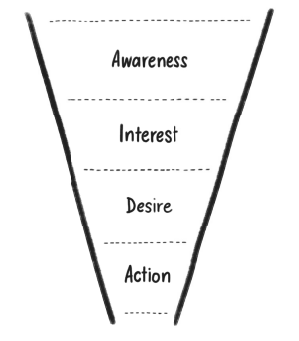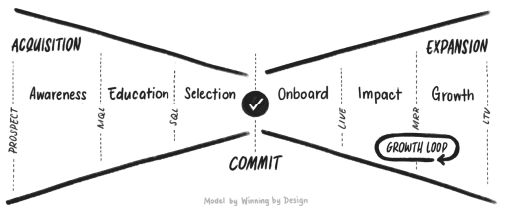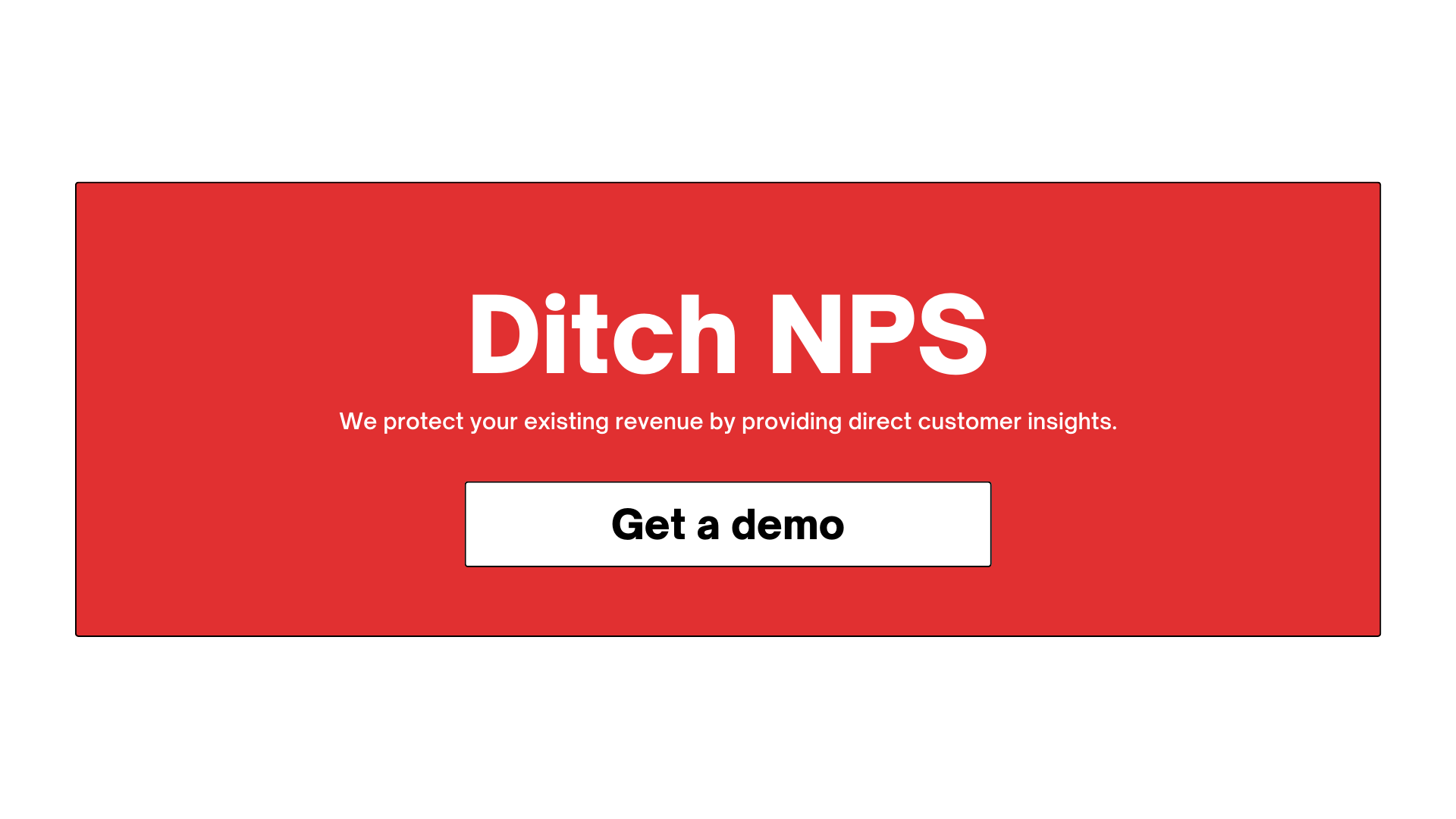
Ethan Beute has spent the last three years hosting The Customer Experience Podcast and the last ten years of his career at BombBomb helping people to implement simple, personal videos for clearer communication, human connection, and higher conversion.
These experiences helped shape the ideas presented in his new book, co-authored with Stephen Pacinelli, called Human-Centered Communication: A Business Case Against Digital Pollution. In this newsletter, we’re highlighting an excerpt from the book featuring Winning by Design founder Jacco van der Kooij and the bow tie funnel he created.
This excerpt focuses on why we should cast aside the traditional funnel where the final step and goal is a customer transaction. Ethan and Jacco propose that we replace it with the bow tie framework which allows us to “devote our effort and expense to what matters most: creating recurring impact for people.”

The Broken Funnel
You’re likely familiar with the traditional sales and marketing funnel like in the figure below. The language changes depending on whose funnel it is, but it typically follows the AIDA structure (Awareness, Interest, Desire, Action). The final step, Action, is a purchase, commitment, sale, conversion, or another form of transaction.

Its flaws have been identified before, but we’ll do so quickly again here. And we’ll start with the fact that the physics are all wrong; people don’t get into the top of your funnel and just slide down the side into a purchase. More importantly, the goal, perspective, and mindset are broken. Among the potential costs of adhering to its flawed simplicity are digital pollution, lost opportunities, transactional culture, and burned reputation.
The Goal Is Broken
The goal of the traditional funnel is to close the sale. However, this transaction is the goal line only in a transactional culture. A funnel that ends with a purchase says: We got what we wanted. But most businesses are relationship-based. The purchase isn’t the end of a process; it’s the start of a long-term relationship. Tacking on the word “Retention” or “Advocacy” underneath “Action” or “Purchase” is a move in the right direction but doesn’t get us where we need to be.
In a subscription model, a purchase may not even be profitable for you. Instead, you must renew or upgrade a subscription over many months to reach profitability. Even if you’re not in a subscription-based business, you rely on recurring revenue in the form of repeat purchasing, expanded purchasing, and customer referrals. No matter the model, a healthy business grows with and through current customers, not by creating a costly parade of one-time transactions. You want to grow the lifetime value of each customer, not just close deals.
The Perspective Is Broken
The traditional funnel is created from the seller’s perspective. When it gets operationalized, we tally up the people and potential revenue at each stage, track conversion rates by stage, measure pace through each stage, and so on. Its purpose is accurate revenue forecasting. Its bias is toward getting the deal closed, not on developing the deal. For example, in five common stages of a sales funnel (contacted, qualified, demo, proposal, closed), four stages are dedicated to getting the deal done, but only one (qualified) is dedicated to discovery. And that’s assuming qualification comes through a curiosity-based conversation. Regardless, the seller’s needs and wants overshadow the buyer’s.
The Mindset Is Broken
In Jacco’s example earlier in the chapter, our default plan to double revenue from $80,000 to $160,000 is to double the top of the funnel. Double the calls. Double the emails. Double the connection requests. Double everything. This volume-based approach is driven by an alpha culture demanding that people and machines crank out activities, rely on size and force, and ignore counter impacts.
“That whole mindset is deeply ingrained into the typical sales culture,” observes Jacco. But “there is scientific proof that shows that twice the volume does not bring in twice the results.”
To illustrate, Jacco shares the story of the elusive four-minute mile. For years, it was thought to be an unbreakable barrier for runners. Most contenders had the mindset of running more and more, training more miles into their bodies. A doctor working in a hospital lab, Roger Bannister didn’t have time for volume. Instead, he focused on interval training—shorter bursts to increase speed. One of his favorite track sessions consisted of three 1.5-mile runs at a swift pace.
“What he learned is that running less made him go faster,” explains Jacco. He was the first to break the four-minute mile barrier in 1954.
Bannister’s counterintuitive approach opened the door. Though three times as many humans have summited Mount Everest than have run a sub-four-minute mile (approximately 5,000 versus fewer than 1,500), most major college track teams now have a sub-four-minute miler.
This story sets up the third of three of nonnegotiable principles of sales that Jacco shares with us. Each principle demands a better funnel with better processes and better communication:
- Recurring revenue is a result of recurring impact.
- People love to buy, but they don’t like to be sold to.
- The impact of marginal gain is better than volume.
Each of these principles helps fix the broken funnel.
The Bow Tie Funnel
A better funnel is The Bow Tie Funnel, which Steve and I learned from Jacco’s books and videos. As you can see in the figure below, it’s shaped like a bow tie. This funnel views the transaction, purchase, or commitment not as the end, but as the start of an ongoing impact journey. In this way, it involves your entire organization and starts from a more customer-centric perspective.

As we co-create with our customers their journey across the funnel into a positive growth loop, we work to deliver emotional impact (how it benefi ts the individual) and rational impact (how it benefits their organization). Impacts are problems solved, opportunities gained, and value delivered. The more we understand our customers and build trusting relationships with them, the more impact we can deliver. The delivery of impact earns us the right to revenue.
For a quick orientation to The Bow Tie Funnel, the three main stages are Acquisition, Commitment, and Expansion.
On the Acquisition side, which is typically the domain of marketing and sales, prospective customers become aware of their problem or opportunity, get educated on solutions, and select one of the providers competing for their business.
On that path, they’re qualified by marketing (MQL) and then by sales (SQL), who work to earn a commitment. When customers Commit, they’re onboarded into the product or service and guided to initial impact. Helping them achieve that desired outcome generates monthly recurring revenue (MRR). As we continue to provide impact for customers, they grow and expand with us, increasing lifetime value (LTV) over a long-term relationship.
Even if you don’t use this language to describe your business, you can use The Bow Tie Funnel. No matter the size of your team or your customer base, this model applies. Whatever your product or service may be, you can view relationship building, value delivery, and revenue generation through this lens.
The Goal Is Better
With this funnel, the sale isn’t the goal—customer impact is. It doesn’t end with a purchase; it looks to an ongoing growth loop. It is inherently customer centric.
This bears out Jacco’s first principle: Recurring revenue is a result of recurring impact.
The Perspective Is Better
The Bow Tie Funnel takes the customer’s perspective. Their benefit (impact) is a necessary precursor to our benefit (revenue). It demands we stop selling and start helping. It demands we think first about their needs, not our own.
This reinforces his second principle: People love to buy, but they don’t like to be sold to.
The Mindset Is Better
The path to doubling revenue isn’t to double the top of the funnel, it’s to create more impact for your customers.
Math fact: 10% to the power of seven is 1.8. Therefore, creating a 10% improvement in each of the seven main stages across The Bow Tie Funnel will nearly double revenue. Improving a conversion rate from 4.7% to 5.17% is a 10% improvement. An incremental, human-first approach builds trust, minimizes counter impacts, and grows revenue.
This exemplifies the third principle he shares with us: The impact of marginal gain is better than volume.
A Final Note
“What we’re looking for now is authenticity,” Jacco declares. “I believe that ultimately, this is what we want. People want transparency.”
For too long, we’ve been trained to create the appearance of perfection. The shine and gloss. The impression and illusion. The effort and expense. The call for authenticity is a call for substance over style.
When we drop the facade, we can devote our effort and expense to what matters most: creating recurring impact for people.
Our sales calls and our recruiting interviews start long before we ever meet inperson. Our reputations precede us now more than ever. Our first impression is often made virtually. Word of mouth has been with us for millennia, but its effects are wider and deeper digitally. Now is the time to get intentional about authenticity, transparency, and human centricity.

The best resources for Customer Success teams this week
EVENT
Gainsight’s Pulse Conference
“Venus and Serena. Jordan and Nike. Peter Parker and MJ. Some pairs are just easy to root for. Our favorite? Pulse and You.” Join me and thousands of other Customer Success leaders at Moscone Center for Gainsight’s Pulse Conference on August 17-18.
HIRING
"Take Control of Your Desk" And Other Career Tips
Former Sr. Dir. of Talent Acquisition for Splunk, Shreya Iyer, shares an abundance of career advice including a great section for hiring managers on how to find people looking to grow in their career (and then how to support them along that path). She says, “I think it’s a mistake when people assume job-hopping is a red flag. It’s a yellow flag — you need to dig in deeper. Are they job-hopping because their role and their career is growing, or are they job-hopping because of a lack of focus?”
FRAMEWORK
The Three-Legged Stool
Here’s Rav Dhaliwal with a piece on why Customer Success needs to serve as the third leg on a stool to close the buyer-deployer gap by conducting “deployment discovery” during the sales cycle.
OPINION
Why NRR is Probably The Wrong Core Metric for Your CS Team
Jason Lemkin, founder of SaaStr, says CSMs are the laziest Individual Contributors. What say you?



Submit a comment